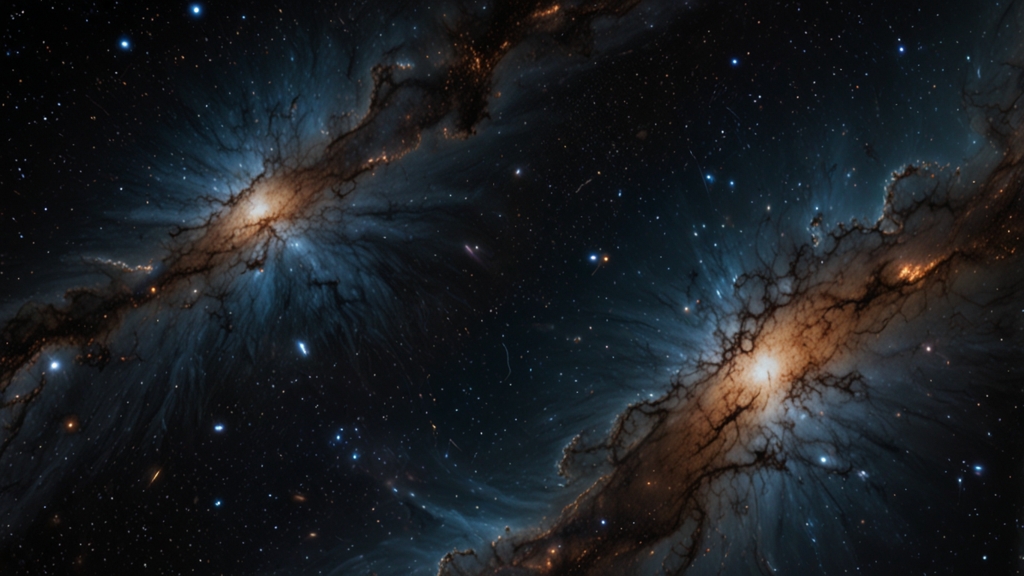The Hidden Truths of Dark Matter: A Journey into the Universe's Shadows
When we gaze into the night sky, the brilliant array of stars, planets, and galaxies captivates our imagination. However, what we see is merely a fraction of the universe's true complexity. Lurking in the shadows lies one of the most enigmatic and elusive components of our cosmos: dark matter. Though it neither emits nor absorbs light, dark matter exerts an unmistakable influence on the gravitational behavior of galaxies and galactic clusters. This article delves into the hidden truths of dark matter, unraveling its mysteries and exploring its profound implications.
What is Dark Matter?
Dark matter is a form of matter that does not interact with electromagnetic forces, meaning it does not emit, absorb or reflect light, making it invisible and detectable only through its gravitational effects. Despite comprising approximately 27% of the universe’s total mass-energy content, its elusive nature makes it one of the most challenging riddles in modern astrophysics.
The Discovery of Dark Matter
The concept of dark matter first emerged in the early 20th century. Astronomer Fritz Zwicky observed the Coma Cluster of galaxies in 1933 and noticed that the galaxies were moving too rapidly to be held together solely by the visible mass. He coined the term "dunkle Materie" (dark matter) to explain the unseen mass exerting gravitational forces.
Later, in the 1970s, Vera Rubin's study of the rotational speeds of galaxies provided further evidence. Rubin discovered that stars at the edges of galaxies were moving just as fast as those near the center, contradicting Newtonian dynamics if only visible matter was present. This implied that a substantial amount of unseen matter, dark matter, was influencing the galaxies’ rotation.
The Nature of Dark Matter
Despite extensive research, the exact composition of dark matter remains unknown. Leading theories suggest that it may be composed of Weakly Interacting Massive Particles (WIMPs) or axions. WIMPs are hypothetical particles that interact only via the weak nuclear force, making them difficult to detect. Axions, on the other hand, are ultra-light particles that likewise evade direct detection.
"The darkness that surrounds us cannot hurt us. It is the darkness in your own heart you should fear." - Silas House
Detecting Dark Matter
Detecting dark matter is akin to searching for a shadow in pitch-blackness. Scientists employ a variety of methods to infer its presence:
- Gravitational Lensing: Dark matter bends light from distant galaxies, making them appear distorted. By studying these distortions, astronomers map the distribution of dark matter.
- Cosmic Microwave Background (CMB): Variations in the CMB provide clues about the distribution and amount of dark matter in the early universe.
- Direct Detection Experiments: These experiments seek to observe WIMPs directly by measuring the minute energy released when they collide with atomic nuclei.
- Particle Accelerators: Facilities like the Large Hadron Collider (LHC) attempt to create dark matter particles by simulating conditions similar to the Big Bang.
The Role of Dark Matter in Cosmic Evolution
Dark matter's gravitational influence plays an essential role in the formation and evolution of cosmic structures. It acts as a cosmic scaffold, pulling visible matter together to form galaxies and galaxy clusters. Without it, the universe's large-scale structures would not have formed as they did.
"The universe, as we observe it, is neither accident nor illusion; it is inevitable." - Arthur C. Clarke
Current Research and Future Prospects
The quest to uncover the nature of dark matter continues to be at the forefront of astrophysical research. Projects like the Dark Energy Survey (DES) and upcoming missions like the Euclid Space Telescope aim to provide more insights. Additionally, advancements in technology and experimental techniques hold the promise of eventually deciphering dark matter’s mysterious properties.
As we journey further into the universe’s shadows, dark matter remains a compelling mystery—a hidden truth of the cosmos whose discovery could unlock profound new understandings of the universe and the fundamental laws of nature that govern it. Our pursuit to comprehend this dark component drives us further into the depths of space, challenging our perceptions and illuminating the vast, unseen corners of the cosmos.








